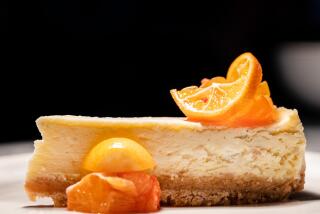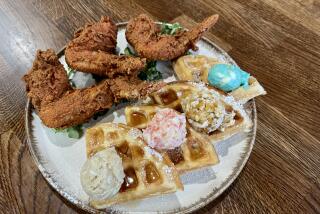It was up in the ‘70s and down in the ‘80s. But, when properly prepared, real quiche is most certainly . . . : Stayin’ Alive
- Share via
Aah, aah, aah, aah--
Stayin’ alive, stayin’ alive.
--The BeeGees, “Stayin’ Alive,” 1977
It’s hard to believe it was almost 20 years ago that those lyrics were first heard. And it probably was just as long ago that you last thought--without flinching--about that other quintessential ‘70s cliche, the quiche.
Back in the disco days, quiche was the white three-piece suit of the food world. It was every home cook’s solution for what to serve for brunch and every cafe’s solution for what to pair with a salad for the daily lunch special. It was omnipresent.
It was also bad. Thanks to the American penchant for taking a perfectly good dish from another country and then bludgeoning it into mediocrity with mismatched ingredients and slipshod cooking techniques, quiche became a parody of the original French dish. By the time Bruce Feirstein wrote his 1982 best-seller, “Real Men Don’t Eat Quiche,” it wasn’t just men who were sick of it.
But quiche is reviving. Sometimes it has to be called a tart for people to try it; sometimes it has to be made into cutesy little finger food. But caterers, cafes and carryout counters are selling it again, and customers are giving it a second chance.
Chef David Hagedorn at the Washington restaurant Trumpets has even put it on his menu with the triumphant title, “Return of the Classic Quiche.” Actually, it’s not quite classic--his summer version was made with pepper Jack cheese, spinach and bacon; the one on the fall menu has goat cheese--but the custard is creamy and the crust is crisp, and it’s winning converts. “It does very well at brunch and even better than I expected at dinner,” Hagedorn says.
“We have done a lot of bad things to a good recipe,” says culinary historian Barbara Ketcham Wheaton, curator of the culinary collection at the Schlesinger Library at Radcliffe College and author of the recently published “Savoring the Past: The French Kitchen and Table From 1300 to 1789” (Scribner’s).
The original French quiche had a bread crust (like pizza, it was a baker’s way of using up odds and ends of dough at the end of the day while his oven was still hot) with seasonings and some egg to help anchor them. From there, says Wheaton, it evolved to a pastry crust with a savory custard filling baked in a shallow tart pan. The original quiche Lorraine had only bacon in the eggy filling; cheese was a variation that was added later.
But somehow, after the trip across the Atlantic, the thin French quiche with the crisp crust and simple filling became a deep-dish pie with a flabby crust and a filling that was used, as Wheaton scornfully put it, as a way to clean out your refrigerator.
“We started dumping everything into it,” she says, “like broccoli and raw mushrooms, which ooze liquid and guarantee a soggy crust. No wonder people think quiche tastes terrible.”
Pastry chef Nick Malgieri, who includes a recipe for the original quiche Lorraine in his new cookbook “How To Bake” (HarperCollins), believes we have done to quiche what we did to pizza: top it with all kinds of inappropriate ingredients just because they happen to be “in” at the moment. “Please,” he pleads, “no quiche with sun-dried tomatoes or smoked salmon.”
He serves quiche for lunch to his baking students and teaches them how to make it in a tart pan with a simple filling. “There are appropriate vegetables you can add, like some cooked and well-drained asparagus, but the minute you start mentioning them, someone wants to put in raw carrots or bits of leftover vegetables. Quiche is not a recycling container,” he admonishes.
BACON AND CHEESE QUICHE
CRUST
1 1/4 cups flour, plus extra for working dough
1/4 teaspoon salt
1/4 teaspoon baking powder
6 tablespoons cold unsalted butter, cut into 6 pieces
1 large egg
1 tablespoon cold water
FILLING
1/4 pound thick-sliced bacon, cut into 1/2-inch pieces
1/2 cup milk
1/2 cup whipping cream
3 large eggs
1/4 teaspoon salt
1/4 teaspoon freshly ground white pepper
Pinch freshly grated nutmeg
1 cup grated Gruyere, Emmenthal or Cheddar cheese
2 tablespoons unsalted butter
This quiche, from Nick Malgieri’s “How to Bake,” is a perfect example of a simple, yet elegant, brunch or lunch dish.
*
CRUST
Combine flour, salt and baking powder in medium mixing bowl or bowl of food processor fitted with steel blade. Stir or pulse to mix. Add butter to dry ingredients and toss or pulse once to coat pieces of butter. Rub butter into dry ingredients by hand or with pastry blender, or, if using food processor, pulse at 1-second intervals until mixture resembles coarsely ground cornmeal and no large pieces of butter remain visible.
Beat egg and water together in small bowl and pour over flour mixture. Stir with fork or pulse 10 times or so, until dough begins to form ball.
Scatter teaspoon of flour over work surface and scrape dough out onto it. Press and knead dough quickly 3 or 4 times, until dough is smooth and uniform.
Press dough into circle. Sandwich between 2 pieces of plastic wrap and press into 6-inch circle. Refrigerate dough until firm, or until ready to use, or at least 1 hour.
When ready, roll out dough to fit into 9- to 10-inch tart pan with removable bottom. Chill crust while preparing filling.
*
FILLING
Place bacon in 1 1/2-quart saucepan and cover with cold water. Bring to boil over low heat and drain water immediately. Return bacon to pan and cook over low heat until bacon renders some fat and begins to sizzle, about 5 minutes. Do not cook bacon until crisp, or bacon will be hard in quiche. Remove bacon pieces from pan and place on plate lined with paper towel to drain.
Combine milk, whipping cream, eggs, salt, pepper and nutmeg in bowl and whisk to blend. Arrange bacon and grated cheese evenly over chilled crust and strain filling over top. Dot with butter.
Bake quiche on lowest level of 375-degree oven until pastry is baked through and filling is set and puffed, about 40 minutes.
Remove from oven and place on rack to cool briefly. To unmold, stand pan on large can or canister and allow rim to fall away. Slide quiche from pan’s bottom onto large flat-bottomed platter.
Makes 8 servings.
Each serving contains about:
351 calories; 341 mg sodium; 178 mg cholesterol; 27 grams fat; 17 grams carbohydrates; 11 grams protein.
PEPPER AND ONION FRITTATA TART WITH CORNMEAL CRUST
CRUST
3/4 cup plus 1 teaspoon flour, plus extra for working dough
3/4 cup yellow cornmeal
1 teaspoon salt
1/2 teaspoon baking powder
6 tablespoons cold butter, cut into 6 pieces
1 egg
FILLING
3 red, green or yellow bell peppers (about 1 pound total)
1 medium red onion (about 1/4 pound)
3 tablespoons olive oil
1/2 teaspoon salt
1/2 teaspoon black pepper
1 tablespoon chopped fresh marjoram, or 1 teaspoon dried
1 cup whole-milk ricotta cheese (or substitute part-skim ricotta)
4 eggs
1/4 cup grated Parmesan cheese
CRUST
Combine 3/4 cup flour with cornmeal, salt and baking powder in medium mixing bowl or bowl of food processor fitted with steel blade. Stir or pulse to mix. Add butter to dry ingredients and toss or pulse once to coat pieces of butter. Rub butter into dry ingredients by hand or with pastry blender, or, if using food processor, pulse at 1-second intervals until mixture resembles coarsely ground cornmeal and no large pieces of butter remain visible. Beat egg in small bowl and pour over flour mixture. Stir with fork or pulse 10 times or so, until dough forms ball.
Scatter 1 teaspoon of flour over work surface and scrape dough out onto it. Press and knead dough quickly 3 or 4 times, until it is smooth and uniform.
Press dough into circle. Sandwich dough between 2 pieces of plastic wrap and press into 6-inch circle. Refrigerate dough until firm, or until ready to use, or at least 1 hour.
Place dough on lightly floured work surface and scatter flour over. Roll dough out into 13- to 14-inch circle. Fit dough into 9- to 10-inch tart pan with removable bottom and trim away all but 1/2 inch of excess around edge of pan. Fold excess back into pan. Press dough firmly against bottom and side of pan, then, using thumb and index finger of one hand, press against side of the crust and down on top edge to make rim smooth and even.
FILLING
Slice peppers and onion thin. Heat olive oil in wide, shallow pan and add peppers and onion. Season with salt and pepper and cook over medium heat, stirring or tossing frequently, until vegetables are wilted, about 10 minutes. Stir in marjoram, pour into mixing bowl and cool. Place ricotta, eggs and Parmesan in a food processor and process for about 1 minute until smooth.
Combine ricotta and pepper mixtures, correct seasonings if necessary, and pour into crust. Bake in lower third of 350-degree oven until filling is set and crust baked through, about 30 to 40 minutes. Remove from oven and cool on rack.
To unmold tart, stand pan on large can or canister and allow rim to fall away. Slide tart from pan’s bottom onto large flat-bottomed platter.
Serve warm or at room temperature.
Makes 8 to 10 servings.
Each serving contains about:
343 calories; 527 mg sodium; 175 mg cholesterol; 22 grams fat; 25 grams carbohydrates; 12 grams protein.
More to Read
Eat your way across L.A.
Get our weekly Tasting Notes newsletter for reviews, news and more.
You may occasionally receive promotional content from the Los Angeles Times.









